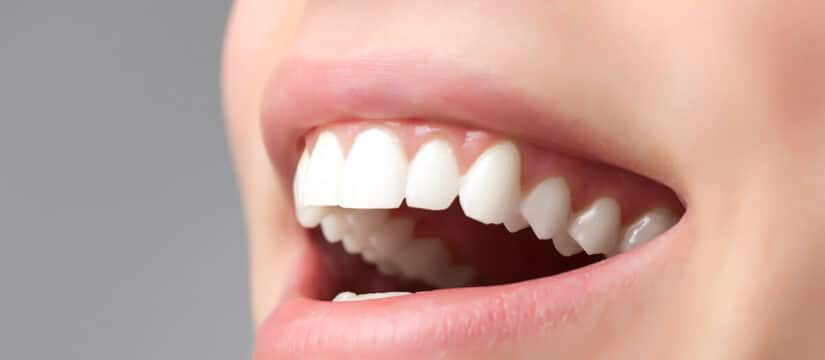
The simple answer is, no. If your gums are damaged by, for example by gum disease such as periodontitis, it’s not possible for those receded gums to grow back. However, even though receding gums can’t be reversed there are treatments that can help to stop the problem from getting worse.
HOW CAN I TELL IF I HAVE RECEDING GUMS?
There are a few signs you can look out for that can tell you if you have any gum problems. Gum recession happens when your gums pull away from your teeth and seem to ‘shrink’ down, leaving the root beneath exposed leaving you with increased tooth sensitivity. You might also notice that your teeth look longer, more yellow or feel a ridge where the gum meets the tooth.
While you may notice these signs, it’s not always easy to tell if you have receding gums. The best thing to do is have regular check up and cleans with your dentist at Coomera Dental Centre,as our trained professionals can easily identify and treat array of gum problems. This is particularly important with receding gums as getting treatment as soon as possible is the best way to stop them from getting worse.
WHAT CAUSES RECEDING GUMS?
There are many factors that can cause your gums to recede and your Dentist will be able to tell you which is causing your gum recession, such as:
- Brushing your teeth too hard – this can wear away the enamel on your teeth therefore making your gums recede.
- Selecting the wrong toothbrush – remember to only select a soft toothbrush as choosing a medium or hard toothbrush will literally brush away your enamel and gum. Keep it soft and gentle.
- Poor oral health – if you don’t keep your teeth clean with regular brushing and flossing daily, plaque can build up and turn into a hard deposit called tartar. If this isn’t removed it can lead to gum disease and gum recession.
- Grinding or clenching your teeth – if this is severe it can put pressure on your gums causing them to recede and become loose in time.
- Smoking – if you smoke you are more likely to get receding gums.
- Periodontitis – In severe gum disease, called periodontitis, the gums can pull away from the teeth and form deep pockets. These may become inflamed, infected and when they do this can damage the tissue and bone that holds teeth in place making them loose and wobbly. Long term it leads to tooth loss resulting in you requiring a bridge or dental to replace the tooth.
HOW CAN I STOP RECEDING GUMS?
If you think you may have gum recession and want to confirm if you do, the first thing to do is book an appointment to see your Dentist at either of our clinics and get some professional advice on appropriate treatment. There are several receding gum treatments including:
- SCALING AND ROOT PLANING
In cases of gum recession, your dentist might suggest deep scaling and root planing. This procedure is completed in two parts. Firstly, all the plaque and hardened calculus above and below the gum line (where the gum meets the tooth) is removed at times with the use of local anesthetic for your comfort. Your dentist will then commence the root planing, which is smoothing out your teeth roots to help the gums reattach to the teeth. Your dentist will also offer a local anesthetic during the procedure and it may take more than one visit to complete. After your treatment it’s normal for your gums to be red, agitated, swollen and tender for a few days. You may also notice increased sensitivity however this will settle down. Your Dentist may also recommend using a short course of antimicrobial mouthwash like Savacol to help reduce bacteria and prevent further infection.
Following deep scaling and root planing you will be required to have regular checkups to make sure your receding gums have improved and are not getting worse. It’s also important to maintain a good oral health routine to protect your gums.
- GUM SURGERY
For more severe cases of receding gums and if non-surgical treatment hasn’t worked, your Dentist may recommend referring you to a Periodontist Specialist. There are few different options of surgery available including:
Open flap scaling and planing: Open flap scaling and planing, where the affected gum tissue is delicately folded back to get better access to clean and smooth the roots. The gum is then reattached snugly with some stitches, making it easier to keep clean and promote the gum to reattach and be healthier.
Regeneration: This surgical treatment can help to regenerate the damaged bone and gum tissue. The specialist will clean above and below the gum to remove all bacteria and plaque. Then a regenerative material – a membrane, tissue-stimulating protein or graft tissue, will be applied to encourage your body to naturally restore the damaged bone and tissue. The gum is then securely reattached over the root of the tooth.
Gum Grafts: If gum tissue has been lost your dentist may suggest soft tissue, or gum graft, surgery. This is where tissue is grafted from surrounding gums or the roof of your mouth and stitched to the gum tissue to cover the exposed root of your tooth.
HOW CAN I HELP TO PREVENT RECEDING GUMS
The best protection against receding gums is regular checkups with your Dentist at Coomera Dental Centre and good oral health routine. Brushing for two minutes, twice daily with a soft toothbrush and a fluoride toothpaste to keep your gums, and teeth, healthy.
